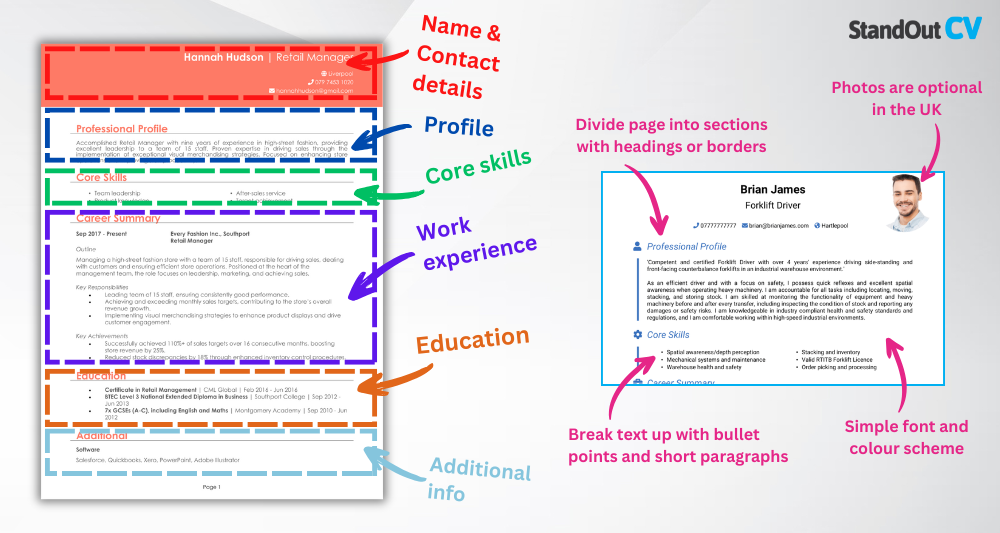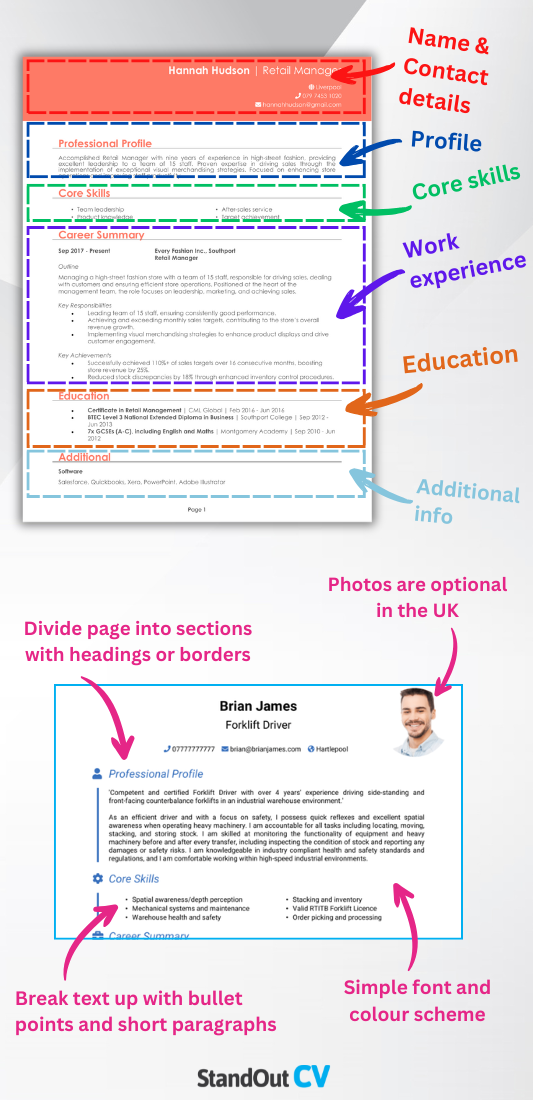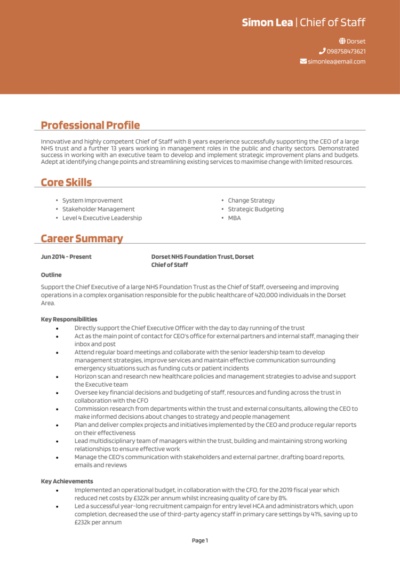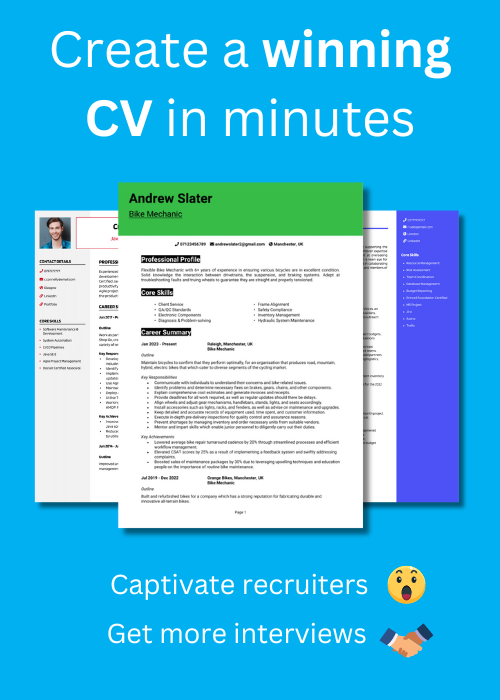You might not always be the one in the spotlight, but you’re the one making sure everything runs smoothly behind the scenes. It’s a lot of responsibility, so your CV will need to inspire a lot of confidence in hiring managers if you’re hoping to get hired.
If your next step is a new challenge, you’ll need a CV that clearly reflects the scope of what you do. This guide (with a Chief of Staff CV example) will enable you to walk into any senior role you’re after.
Chief of Staff CV

How to write your Chief of Staff CV
Discover how to craft a winning Chief of Staff CV that lands interviews with this simple step-by-step guide.
A Chief of Staff CV should be clear and focused – just like your approach to the job. You’re not just managing operations or overseeing communications – you’re making sure the right people, information, and systems are in place to support leadership and drive progress.
This guide will help you with producing a CV that showcases your strategic execution and the value you add at the highest level of an organisation.
Chief of Staff CV format and structure guidelines


In a Chief of Staff role, you’re expected to bring clarity and order – and your CV structure should demonstrate those qualities right from the start. Decision-makers won’t sift through dense paragraphs or mistakes. They want a CV that delivers key information fast and positions you as a trusted partner to leadership.
Here’s the layout to follow:
- Name and contact details – Ensure your name and personal details are easily visible at the top. A photo is optional and depends on the role.
- Profile – Craft a short introduction that showcases your professional background and key accomplishments.
- Core skills – Provide a quick overview of your top skills that show why you’re a great fit.
- Work experience – Outline your career progression in reverse order, emphasising your contributions and achievements.
- Education – Provide details on your academic background, including certifications or specialised training.
- Additional info – You can add hobbies or activities here that reflect your enthusiasm for the industry.
While writing a CV, make sure you use bullet points to nicely break down large bodies of text into skimmable points. Stick to a clean, readable font, divide sections with clear headings, and keep your CV to two pages in length. A pleasant CV format mirrors the same executive presence and discipline that the role demands, so follow these tips to impress recruiters before they even start reading.
Creating a strong Chief of Staff profile


Your profile should introduce you as a confident leader, skilled at navigating executive environments and translating big-picture goals into tactical execution. This is where you highlight your sector experience and operational scope. Since your CV profile is the first thing recruiters see when they open up your application, you’ll need to cover all the essentials in a concise and focused way.
Chief of Staff CV profile examples
Profile 1
Strategic and highly organised Chief of Staff with over eight years of experience supporting C-suite leadership in global corporate environments. Skilled in executive decision support, operational planning, and cross-functional coordination. Adept at managing priorities, streamlining workflows, and acting as a key liaison between departments. Known for discretion, analytical thinking, and driving business efficiency at the highest levels.
Profile 2
Experienced Chief of Staff with a background in consultancy and executive operations, supporting CEOs and senior leaders in fast-paced, high-growth companies. Proficient in board-level communications, strategic planning, and change management. Brings excellent problem-solving abilities, stakeholder engagement skills, and a proactive approach to organisational leadership.
Profile 3
Results-driven Chief of Staff with a decade of experience overseeing key strategic initiatives and aligning senior leadership goals with operational execution. Proven success in managing special projects, leading executive communications, and facilitating internal collaboration. Recognised for maintaining high levels of trust, influencing decision-making, and improving executive productivity.
Details to put in your Chief of Staff CV profile
Here’s what to include:
- Where you’ve worked – High-growth start-ups, global firms, or corporate HQs.
- Your top qualifications – MBAs, strategy training, or project management credentials.
- Core traits – Strategic operator, cross-functional collaborator, leadership advisor.
- Operational focus – Change management, internal communications, project oversight.
- Leadership support – Experience supporting founders, C-suite, or board-level executives.
Show off the core skills recruiters look for


This section should reflect the wide-ranging capabilities of your role, from managing operations to influencing executive decisions. Keep your CV skills focused and relevant to the role you’re applying for – aim to show breadth without sounding too general.
Prioritise leadership, communication, systems thinking, and strategic alignment – framed as actionable strengths rather than vague buzzwords. This section helps recruiters instantly grasp your value without needing to read between the lines.
Most important skills for a Chief of Staff
- Executive Support and Strategic Planning – Assisting the CEO or executive team with high-level decision-making, long-term planning, and organisational strategy.
- Project and Initiative Oversight – Leading cross-functional projects, tracking progress, and ensuring alignment with business priorities.
- Internal Communication Management – Acting as a liaison between departments and leadership to ensure clear and consistent messaging.
- Operations Coordination – Streamlining workflows, improving efficiency, and managing day-to-day operations across business units.
- Meeting and Agenda Management – Preparing executive meeting agendas, briefing documents, and follow-up actions to drive productivity.
- Data Analysis and Reporting – Gathering and interpreting key business metrics to inform strategy and executive decisions.
- Team Alignment and Leadership Support – Coordinating with senior leaders to ensure teams remain focused on shared goals and deliverables.
- Problem-Solving and Decision Support – Addressing organisational challenges and supporting executives with timely, well-informed recommendations.
- Confidential Project Management – Handling sensitive and high-impact initiatives with discretion and accountability.
- Change Management Facilitation – Supporting company-wide transformation efforts and ensuring smooth implementation of new policies, systems, or structures.
Describing your work experience


This section is your opportunity to show how you’ve turned leadership direction into delivery. Whether you’ve worked alongside a CEO or helped launch major initiatives, focus on your ability to connect operations to outcomes.
Start with your most recent work experience position and work backwards, aiming to explain the full scope of your responsibilities and the results you delivered. Emphasise any work that helped the leadership team make faster, better decisions.
What’s the correct way to structure job history on your CV?

- Outline – Briefly describe the business, the leadership team you supported, and your role in the wider structure.
- Responsibilities – Use action words like “orchestrated,” “aligned,” “streamlined,” or “facilitated.”
- Achievements – Focus on impact: “Introduced cross-functional OKRs,” “Reduced leadership meeting prep time by 40%,” or “Managed a £3M transformation budget with zero overrun.”
Sample work experience for a Chief of Staff
Chief of Staff | Oceana Tech Group
Outline
Supported the CEO of a global software company in aligning strategic objectives across executive teams, overseeing special projects, and driving operational excellence.
Responsibilities
- Managed executive calendars, board prep, and internal communication across departments.
- Coordinated strategic planning sessions and tracked progress on key business priorities.
- Led cross-functional initiatives to address operational bottlenecks and reporting gaps.
- Acted as liaison between the CEO and senior stakeholders across global offices.
- Produced briefing materials and internal reports to support executive decision-making.
Achievements
- Reduced CEO administrative workload by 30% through streamlined processes and delegation.
- Oversaw delivery of a company-wide reorganisation project on time and within budget.
- Recognised by the executive board for exceptional leadership coordination and discretion.
Chief of Staff | Tivaro Financial Services
Outline
Provided executive support to the Managing Director of a national financial firm, facilitating internal strategy execution and stakeholder communication.
Responsibilities
- Chaired weekly operational meetings and coordinated follow-up actions across senior teams.
- Oversaw preparation of board documents, KPIs, and performance dashboards.
- Managed confidential HR and risk-related projects at the executive level.
- Worked with department heads to align annual goals and ensure timely reporting.
- Drafted internal communications, company updates, and CEO announcements.
Achievements
- Increased senior team alignment through structured reporting and communication processes.
- Led a firm-wide strategy refresh that improved executive visibility and accountability.
- Delivered a £150k cost-saving initiative by identifying duplicated efforts across departments.
Chief of Staff | Northbridge Healthcare Group
Outline
Supported the Chief Executive in managing healthcare group operations across multiple NHS partnership sites, focusing on governance, strategic programmes, and executive administration.
Responsibilities
- Monitored delivery of group-wide transformation projects and chaired steering group meetings.
- Drafted briefing notes, proposals, and correspondence for internal and external stakeholders.
- Worked closely with clinical and operational leads to ensure programme alignment.
- Maintained oversight of key governance documents, risk logs, and audit preparation.
- Provided confidential support on HR matters and senior-level organisational changes.
Achievements
- Successfully coordinated delivery of a £10M transformation programme across six sites.
- Improved executive decision-making timelines by introducing a new governance tracker.
- Commended by the CEO for diplomacy, organisation, and cross-functional leadership.
What should your CV’s education section include?


Your education section should back up your leadership capability with academic credibility. Include degrees in business, law, economics, or any subject relevant to strategy or operations. If you have an MBA or executive leadership certification, that belongs here too.
Also include additional training in agile delivery, project management, or any specialist knowledge – but keep this section concise, as recruiters care more about your experience.
What qualifications do employers look for in a Chief of Staff?
- MBA (Master of Business Administration) – A strong foundation in leadership, strategy, and finance.
- Project Management Qualification (e.g. PRINCE2, PMP) – Demonstrates ability to oversee large-scale initiatives.
- BA or BSc in Business, Politics, Law, or Economics – Relevant academic foundation for strategic thinking.
- Executive Coaching or Leadership Development Course – Adds credibility for C-suite advisory roles.
- Change Management Certification (e.g. Prosci) – Valuable for supporting transformation and growth initiatives.





